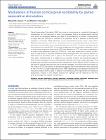| dc.contributor.author | CARSON, RICHARD | en |
| dc.date.accessioned | 2014-11-26T12:55:45Z | |
| dc.date.available | 2014-11-26T12:55:45Z | |
| dc.date.issued | 2013 | en |
| dc.date.submitted | 2013 | en |
| dc.identifier.citation | Carson RG, Kennedy NC, Modulation of human corticospinal excitability by paired associative stimulation., Frontiers in human neuroscience, 7, 2013, 823 | en |
| dc.identifier.other | Y | en |
| dc.identifier.uri | http://hdl.handle.net/2262/72198 | |
| dc.description | PUBLISHED | en |
| dc.description.abstract | Paired Associative Stimulation (PAS) has come to prominence as a potential therapeutic intervention for the treatment of brain injury/disease, and as an experimental method with which to investigate Hebbian principles of neural plasticity in humans. Prototypically, a single electrical stimulus is directed to a peripheral nerve in advance of transcranial magnetic stimulation (TMS) delivered to the contralateral primary motor cortex (M1). Repeated pairing of the stimuli (i.e., association) over an extended period may increase or decrease the excitability of corticospinal projections from M1, in manner that depends on the interstimulus interval (ISI). It has been suggested that these effects represent a form of associative long-term potentiation (LTP) and depression (LTD) that bears resemblance to spike-timing dependent plasticity (STDP) as it has been elaborated in animal models. With a large body of empirical evidence having emerged since the cardinal features of PAS were first described, and in light of the variations from the original protocols that have been implemented, it is opportune to consider whether the phenomenology of PAS remains consistent with the characteristic features that were initially disclosed. This assessment necessarily has bearing upon interpretation of the effects of PAS in relation to the specific cellular pathways that are putatively engaged, including those that adhere to the rules of STDP. The balance of evidence suggests that the mechanisms that contribute to the LTP- and LTD-type responses to PAS differ depending on the precise nature of the induction protocol that is used. In addition to emphasizing the requirement for additional explanatory models, in the present analysis we highlight the key features of the PAS phenomenology that require interpretation. | en |
| dc.format.extent | 823 | en |
| dc.language.iso | en | en |
| dc.relation.ispartofseries | Frontiers in human neuroscience | en |
| dc.relation.ispartofseries | 7 | en |
| dc.rights | Y | en |
| dc.subject | translational neuroscience | en |
| dc.subject | transcranial magnetic stimulation | en |
| dc.subject | spike-timing dependent plasticity | en |
| dc.subject | peripheral nerve stimulation | en |
| dc.subject | long-term potentiation; | en |
| dc.subject | long-term depression | en |
| dc.subject | human | en |
| dc.subject | cortex | en |
| dc.title | Modulation of human corticospinal excitability by paired associative stimulation. | en |
| dc.type | Journal Article | en |
| dc.type.supercollection | scholarly_publications | en |
| dc.type.supercollection | refereed_publications | en |
| dc.identifier.peoplefinderurl | http://people.tcd.ie/ricarson | en |
| dc.identifier.rssinternalid | 90282 | en |
| dc.identifier.doi | http://dx.doi.org/10.3389/fnhum.2013.00823 | en |
| dc.rights.ecaccessrights | openAccess | |
| dc.subject.TCDTheme | Neuroscience | en |




